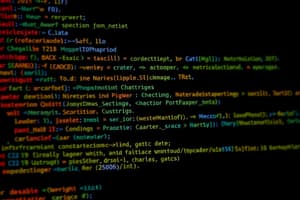Podcast
Questions and Answers
What is the purpose of the createElement() method in DOM manipulation?
What is the purpose of the createElement() method in DOM manipulation?
- To set the HTML content of an element
- To select an element using a CSS selector
- To create a new element (correct)
- To remove an element from the document
What is the mechanism that allows objects to inherit properties and methods from their prototypes in OOP?
What is the mechanism that allows objects to inherit properties and methods from their prototypes in OOP?
- Polymorphism
- Prototype chain (correct)
- Encapsulation
- Inheritance
What is the purpose of the async/await syntax in async programming?
What is the purpose of the async/await syntax in async programming?
- To handle errors in asynchronous operations
- To simplify asynchronous code using promises (correct)
- To execute code synchronously
- To create a promise
What is the scope of the let and const variables in JavaScript?
What is the scope of the let and const variables in JavaScript?
What is the purpose of the querySelector() method in DOM manipulation?
What is the purpose of the querySelector() method in DOM manipulation?
What is the purpose of a callback function in async programming?
What is the purpose of a callback function in async programming?
What is the difference between synchronous and asynchronous programming?
What is the difference between synchronous and asynchronous programming?
What is the purpose of the innerHTML property in DOM manipulation?
What is the purpose of the innerHTML property in DOM manipulation?
What is the concept of inheritance in OOP?
What is the concept of inheritance in OOP?
What is the purpose of the promise object in async programming?
What is the purpose of the promise object in async programming?
Flashcards are hidden until you start studying
Study Notes
DOM Manipulation
- What is DOM?: Document Object Model, a programming interface for HTML and XML documents.
- DOM manipulation methods:
createElement(): creates a new elementappendChild(): adds a new element to the documentremoveChild(): removes an element from the documentinnerHTML: sets or gets the HTML content of an elementouterHTML: sets or gets the HTML content of an element, including the element itself
- Selecting elements:
querySelector(): returns the first element that matches a specified CSS selectorquerySelectorAll(): returns all elements that match a specified CSS selector
Object-oriented Programming
- Classes and Objects:
- A class is a blueprint for creating objects
- An object is an instance of a class
- Inheritance:
- A child class inherits properties and methods from a parent class
- Prototype chain:
- A mechanism that allows objects to inherit properties and methods from their prototypes
- This keyword:
- Refers to the current object being executed
Async Programming
- What is async programming?: A programming paradigm that allows multiple tasks to be executed concurrently
- Async programming techniques:
- Callbacks: functions that are passed as arguments to other functions
- Promises: objects that represent the eventual completion or failure of an operation
- Async/Await: a syntax sugar on top of promises
- Async vs Sync:
- Synchronous: code is executed in a sequential manner
- Asynchronous: code is executed concurrently, allowing for non-blocking I/O operations
Syntax
- Variables:
letandconstare block-scoped, whilevaris function-scoped
- Data Types:
- Primitive types: Number, String, Boolean, Null, Undefined
- Complex types: Array, Object, Function
- Operators:
- Arithmetic operators:
+,-,*,/,%, etc. - Comparison operators:
==,!=,===,!==, etc. - Logical operators:
&&,||,!
- Arithmetic operators:
Event Handling
- What is an event?: An occurrence that triggers a response in the application
- Event listeners:
- Functions that are registered to be executed when an event occurs
- Can be attached to elements using methods like
addEventListener()
- Event types:
- Mouse events:
click,mouseover,mouseout, etc. - Keyboard events:
keydown,keyup, etc. - Form events:
submit,change, etc.
- Mouse events:
DOM Manipulation
- DOM stands for Document Object Model, a programming interface for HTML and XML documents.
createElement()is a method that creates a new element.appendChild()adds a new element to the document.removeChild()removes an element from the document.innerHTMLsets or gets the HTML content of an element.outerHTMLsets or gets the HTML content of an element, including the element itself.querySelector()returns the first element that matches a specified CSS selector.querySelectorAll()returns all elements that match a specified CSS selector.
Object-oriented Programming
- A class is a blueprint for creating objects.
- An object is an instance of a class.
- Inheritance allows a child class to inherit properties and methods from a parent class.
- The prototype chain is a mechanism that allows objects to inherit properties and methods from their prototypes.
- The
thiskeyword refers to the current object being executed.
Async Programming
- Async programming is a programming paradigm that allows multiple tasks to be executed concurrently.
- Callbacks are functions that are passed as arguments to other functions.
- Promises are objects that represent the eventual completion or failure of an operation.
- Async/Await is a syntax sugar on top of promises.
- Synchronous code is executed in a sequential manner.
- Asynchronous code is executed concurrently, allowing for non-blocking I/O operations.
Syntax
letandconstare block-scoped, whilevaris function-scoped.- Primitive types include Number, String, Boolean, Null, and Undefined.
- Complex types include Array, Object, and Function.
- Arithmetic operators include
+,-,*,/,%, etc. - Comparison operators include
==,!=,===,!==, etc. - Logical operators include
&&,||, and!.
Event Handling
- An event is an occurrence that triggers a response in the application.
- Event listeners are functions that are registered to be executed when an event occurs.
- Event listeners can be attached to elements using methods like
addEventListener(). - Mouse events include
click,mouseover,mouseout, etc. - Keyboard events include
keydown,keyup, etc. - Form events include
submit,change, etc.
Studying That Suits You
Use AI to generate personalized quizzes and flashcards to suit your learning preferences.




